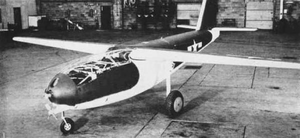Piper LBP
| LBP-1 | |
|---|---|
 | |
| Role | Glider bomb |
| Manufacturer | Piper Aircraft |
| Primary user | United States Navy |
|
| |
The Piper LBP was a glider bomb, or "Glomb", developed by Piper Aircraft for the United States Navy during World War II. Developed as one of three "Glomb" aircraft, the inherent limitations of the Glomb and the technology of the time, combined with difficulties encountered in testing of the prototype, led to the production contract for the LBP-1 being reduced, then cancelled, with none of the Glomb aircraft ever seeing operational service.
Design and development
During late 1940, a proposal was made to the United States Navy outlining a concept called "Glomb", for "glider bomb". The Glomb concept called for the construction of inexpensive gliders, that would be remotely controlled from another aircraft, to carry bombs to a target, thus reducing the risk to aircrew.[1] Glomb was intended to be towed by an ordinary carrier-based aircraft to the area of the target, where it would be released; guidance following release would be provided via a TV camera located in the nose of the glider, which would transmit its signal to a piloted aircraft, an operator then using radio control to steer the Glomb to its target.[2] Following consideration the Glomb concept was deemed to be potentially feasible, the project was given official status by the Bureau of Aeronautics in the April 1941.[1]
Initial trials of Glomb involved conversions of existing gliders to remotely controlled status; these tests showed that the concept had promise, and following a design competition, three companies were awarded contracts to develop operational "Glomb" aircraft. These contracts were given to Pratt-Read, Taylorcraft, and Piper Aircraft. Piper's design, designated LBP-1, was a conventional high-wing monoplane, fitted with tricycle landing gear, and intended to carry 4,000 pounds (1,800 kg) of bombs. Although the LBP-1 was fully capable of being remotely piloted via its TV-and-radio guidance system, it retained a cockpit, allowing the aircraft to be flown by a pilot on board for training and evalulation.[1][2]
Operational history
Although the initial contract awarded by the Navy called for the production of 100 LBP-1 Glombs, continued trials of the concept indicated that the glider's inherent low performance, combined with technical issues with the television guidance system, made the concept operationally unworkable. As a result, the LBP-1 production contract was reduced to only 35 aircraft in early 1945.[1] In June of that year, the LBP-1 program was terminated, the aircraft having been determined to have dangerous characteristics when attempting landing at loaded weights.[3]
Specifications (LBP-1)
Data from [4]
General characteristics
- Crew: One (optional)
- Length: 28 ft 9 in (8.76 m)
- Wingspan: 33 ft (10 m)
- Wing area: 173 sq ft (16.1 m2)
- Gross weight: 6,900 lb (3,130 kg)
Performance
- Maximum speed: 300 mph (483 km/h; 261 kn) in dive
Armament
- Bombs: 4,000 pounds (1,800 kg)
See also
- Related development
- Aircraft of comparable role, configuration and era
- Related lists
References
| Wikimedia Commons has media related to Piper LBP. |
Citations
Bibliography
- "Pilotless Aircraft" (PDF). Naval Aviation News. Bureau of Aeronautics. January 1946. Retrieved 2011-01-29.
- Baugher, Joe (September 9, 2009). "US Navy and US Marine Corps BuNos, Third Series (80259 to 90019)". US Navy and US Marine Corps Aircraft Serial Numbers and Bureau Numbers--1911 to Present. Retrieved 2011-01-29.
- Dryden, Hugh L.; G.A. Morton; I.A. Getting (May 1946). Guidance and Homing of Missiles and Pilotless Aircraft (PDF). Dayton, OH: Headquarters Air Material Command. ASIN B0007E4WJE. Retrieved 2011-01-29.
- Friedman, Norman (1982). U.S. Naval Weapons: every gun, missile, mine, and torpedo used by the U.S. Navy from 1883 to the present day. Annapolis, MD: Naval Institute Press. ISBN 978-0-87021-735-7. Retrieved 2011-01-26.
- Parsch, Andreas (2003). "LB Series". Directory of U.S. Military Rockets and Missiles. designation-systems.net. Retrieved 2011-01-29.